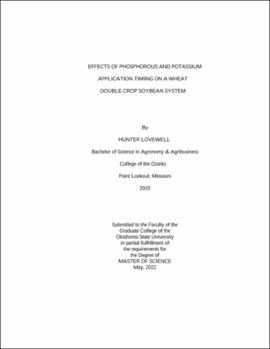| dc.contributor.advisor | Arnall, Brian | |
| dc.contributor.author | Lovewell, Hunter | |
| dc.date.accessioned | 2023-04-03T20:51:27Z | |
| dc.date.available | 2023-04-03T20:51:27Z | |
| dc.date.issued | 2022-05 | |
| dc.identifier.uri | https://hdl.handle.net/11244/337209 | |
| dc.description.abstract | The wheat-double-crop soybean system is a popular choice for Oklahoma producers, as it allows for two crops in one year, and more revenue in less time. With favorable conditions and proper management, double-crop soybeans are yielding similar to full-season soybeans. While attempting to increase yield and profit of the summer crop, it is also important to not limit the potential of the winter wheat crop. This study is designed to evaluate the effects of phosphorus (P) and potassium (K) fertility management for a wheat-double-crop soybean cropping system, over three timings, to better understand how these affect the wheat and soybean yield. The study also determines if OSU fertilization rates based on soil tests are effective. This study consists of 13 treatments replicated 4 times that were established at planting of winter wheat. A total of 6 site-years spread out across Oklahoma over two years made up this research. The plots are 3.0 m x 6.0 m in size. Treatments include a flat N rate (27.2 kg N ha-1) over all plots at both pre-plant wheat and top-dress wheat. Treatments include four rates of P and K each. P and K rates based on OSU sufficiency soil test recommendations. N applied as 28-0-0, P applied as 0-46-0 (P2O5), and K applied as 0-0-60 (K2O). The plots were harvested with a Kincaid 8-XP plot combine unless hand harvested due to poor field conditions. Data collected included yield, test weight, protein, and oil content. Microsoft Excel and SAS 9.4 were used to run statistics for this trial. Oklahoma State University’s winter wheat P and K recommendations based on the sufficiency approach maximized yields when P and K were the only limiting factors. As in previous work, locations with acidic soil pH responded to the addition of P fertilizer above sufficiency recommendations. At one location with low P and pH, in-season application of additional P at top dress maximized yield in wheat. Pre-plant application on soybeans has been found to significantly impact yield in one location, although further investigation of soybean data is needed. | |
| dc.format | application/pdf | |
| dc.language | en_US | |
| dc.rights | Copyright is held by the author who has granted the Oklahoma State University Library the non-exclusive right to share this material in its institutional repository. Contact Digital Library Services at lib-dls@okstate.edu or 405-744-9161 for the permission policy on the use, reproduction or distribution of this material. | |
| dc.title | Effects of phosphorous and potassium application timing on a wheat double-crop soybean system | |
| dc.contributor.committeeMember | Dé Oliveira Silva, Amanda | |
| dc.contributor.committeeMember | Lofton, Josh | |
| osu.filename | Lovewell_okstate_0664M_17704.pdf | |
| osu.accesstype | Open Access | |
| dc.type.genre | Thesis | |
| dc.type.material | Text | |
| thesis.degree.discipline | Plant and Soil Sciences | |
| thesis.degree.grantor | Oklahoma State University | |
